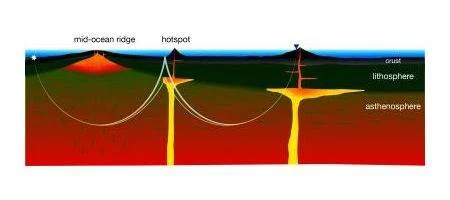The Earth’s wandering continents can’t be fully explained by a layer of partially molten rock about 22 to 75 miles underground, NASA scientists say – something else must be contributing.

The outermost layer of Earth, the lithosphere, consists of the crust and an underlying layer of cool and rigid mantle, and is broken into numerous tectonic plates. Beneath the oceans, it’s relatively thin, about 65 miles, but can be as thick as 200 miles beneath the continents.
Lying beneath the lithosphere is the asthenosphere, a layer of rock that is -very slowly – deforming and flowing. Heat in the Earth’s core produced by the radioactive decay of elements warms the mantle rocks above, making them softer and causing them to convect.
Like the circulating blobs in a lava lamp, rock in the mantle rises where it is warmer than its surroundings, and sinks where it’s cooler, moving the continental plates above.
But many details remain unexplained.
“Something has to decouple the crustal plates from the asthenosphere so they can slide over it. Numerous theories have been proposed, and one of those was that a melt-rich layer lubricates the boundary between the lithosphere and the asthenosphere, allowing the crustal plates to slide,” says Dr. Nicholas Schmerr, a NASA Postdoctoral Program fellow.
“However, since this layer is only present in certain regions under the Pacific plate, it can’t be the only mechanism that allows plate tectonics to happen there. Something else must be letting the plate slide in areas where the melt doesn’t exist.”
Possibilities include the addition of volatile material like water to the rock and differences in composition, temperature, or the grain size of minerals in this region.
Schmerr made his discovery by analyzing the arrival times of earthquake waves at seismometers around the globe. Shear waves, or S-waves, traveling through the Earth bounce or reflect off material interfaces inside the Earth, arriving at different times as a result.
By comparing the arrival times, heights, and shapes of primary and the melt-layer-reflected waves at various locations, Schmerr could estimate the depth and seismic properties of melt layers under the Pacific Ocean basin.
“Most of the melt layers are where you would expect to find them, like under volcanic regions like Hawaii and various active undersea volcanoes, or around subduction zones – areas at the edge of a continental plate where the oceanic plate is sinking into the deep interior and producing melt,” he says.
“However, the interesting result is that this layer does not exist everywhere, suggesting something other than melt is needed to explain the properties of the asthenosphere.”






